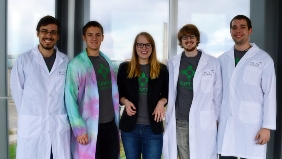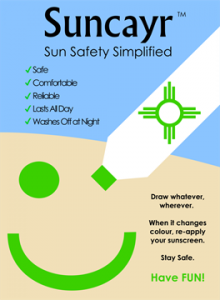It’s not the kind of thing that Canadians spend a lot of time thinking about, particularly in December.
But protection from harmful UV rays and over-exposure to the sun is a big issue these days, no matter what country, no matter what season.

Beautiful…but dangerous.
That’s because as many as one in every three cancers diagnosed worldwide is skin cancer. According to the Canadian Skin Cancer Foundation, more than 80,000 Canadians are diagnosed each year.
So it’s good to know that an innovative Canadian team has made it to the final round of the student competition in the global James Dyson Awards – the first time in the 10 years of the award that has happened.
Suncayr, a team of fourth-year nanotechnology engineering students from the University of Waterloo, are a proud part of the list of international winners and runners up of the 2014 James Dyson Award, the final leg of the competition. These winners were selected by James Dyson, himself an inventor and entrepreneur.
The Dyson competition seeks new ideas that solve specific problems, and protection from the sun’s rays is certainly one such issue we all face.
“Skin cancer is preventable. And the reapplication of sunscreen is one of the greatest challenges to staying safe in the sun,” explained Dr. Michael Smylie, an oncologist at the Cross Cancer Institute in Edmonton and medical advisor to the Canadian Skin Cancer Foundation. “Suncayr has the potential to be a practical tool in preventing skin cancer – and I can see it being fun as well, which means it will get used regularly.”
Suncayr is a UV responsive marker safe to use on the body.
Sun worshippers use the new innovation simply by drawing a design on their skin before applying sunscreen. When the sunscreen is protecting the skin, the ink is one colour. When sunscreen is no longer protecting the skin, the ink will change colour alerting the user to re-apply.
“Our team was inspired to develop a product that would better protect people against the sun’s UV rays, which are harmful to our skin and causes sunburns, skin aging and can lead to skin cancer,” explained Rachel Pautler, Suncayr CEO. We were fed up with being sunburned on days we thought we were being vigilant about re-applying sunscreen, and as engineers, we knew we could create a better solution. Using Suncayr with sunscreen can offer more effective protection against harmful UV rays and will allow people to be safer in the sun.”

Unversity of Waterloo students developing colour changing marker for sun safety (L to R:Andrew Martinko, Derek Jouppi, Rachel Pautler, Hayden Soboleski, Chad Sweeting).
As a runner-up of the James Dyson award, the group will receive about $9,000 CAD (£5,000) to further develop, test and ultimately commercialize their project.
The team has spent more than 3,500 hours on the Suncayr concept already, working late nights, early mornings and weekends to make sure that they can keep the product development on pace.
With the initial prototype complete, they say more development and some big news is coming in 2015.
Suncayr continues its research and development in a lab space provided by Velocity Science, an incubator on-site at the University of Waterloo.
As the completion namesake pointed out, “The consequences of not having adequate sun protection are significant. Suncayr uses visual cues, so it’s obvious when it’s time to reapply sunscreen.” Dyson also underscored another reason for Suncayr’s success, noting that “As with all the best problem-solving designs, it’s very simple to use – but very effective.”
The James Dyson Foundation was set up in 2002 to support design engineering education, medical research and local charities in the Wiltshire area.
The James Dyson Award runs in 18 countries. The contest is open to university level students (or recent graduates) studying product design, industrial design and engineering, who “design something that solves a problem.”
The 2014 James Dyson Award international winner is MOM, a low cost, inflatable incubator for use in the developing world. The design engineer behind MOM is James Roberts, a recent graduate from Loughborough University, UK.
# # #
submitted by Lee Rickwood

A poster touting the benefits of safe sunning.



